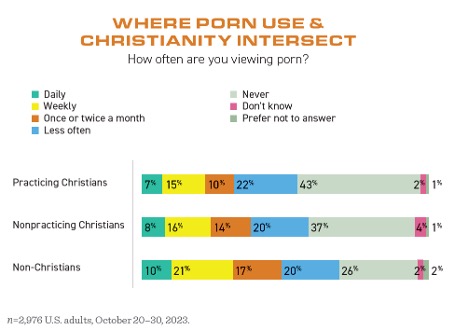This article was originally written by Diana Chandler and published to the Baptist Press.
VENTURA, Calif. (Baptist Press) – Christian men and women use pornography more today than in 2016 when Barna spotlighted the sin among pastors and congregants, an updated study found in calling the church to be a place of healing for those impacted by the pervasive and destructive phenomenon.
This time around, Barna teamed with Pure Desire Ministries and its partners in presenting “Beyond the Porn Phenomenon: Equipping the Church for a New Conversation About Pornography, Betrayal Trauma and Healing.” The report tracks and defines the problem, calls on the church to offer a healing balm and offers practical guidance to that end.

Graph courtesy of the Baptists Press.
“The average Christian is not experiencing freedom in this area; 75 percent of Christian men and 40 percent of Christian women report that they are viewing pornography at least occasionally,” wrote Pure Desire Ministries Executive Director Nick Stumbo, a former pastor who overcame porn use more than a decade ago. “The numbers for today’s youngest adults are even worse.
“But what may be more troubling is that well over half of Christians who use porn say they are comfortable with their porn use.”
In the general population, porn use has increased 6 percentage points among U.S. adults in the past eight years, rising to 61 percent, Barna reported, with use increasing to 44 percent among women from a 2016 mark of 39 percent.
For Christians, 54 percent reported viewing porn in the latest study, compared to 68 percent of non-Christians, a disparity of 14 percentage points that narrows when considering frequency, Barna reported. Nearly a quarter of practicing Christians, 22 percent, view porn at least weekly, compared to 31 percent of non-Christians.
But most churches are not addressing the problem, respondents said. Only 10 percent of Christians and churched adults said their churches offer programs to help those struggling with porn use and addiction, but 58 percent of Christian or churched adults want their church to do so.
Despite the low percentage of churches addressing the problem, 75 percent of pastors said they are individually ministering to those struggling with porn, and 51 percent of those seeking help are married men, pastors said.
Among pastors themselves, 18 percent cite porn use as a current personal struggle, and 67 percent have a history of porn use. Most of them, 86 percent, believe porn use is common among Christian pastors, study authors wrote.
When churches do address the issue of pornography, they often overlook the full problem, said Sam Black, an expert in pornography recovery with Covenant Eyes. Churches often don’t see past the spiritual harm, he said in a roundtable discussion included in the report.
“Churches often miss the physical healing that is necessary. They miss that spouses need healing from their partner’s betrayal. And they often completely miss that women watch porn,” Black said. “Leaders often fail at providing people with an understanding of how pornography can be damaging.
“Most churches fail to recognize that pornography undermines every ministry of the local church.”
While churches offer children’s ministry, host marriage seminars, date nights and weekend retreats, inappropriate content is available to children as never before, Black said, and porn is cited as a contributing factor in many divorces.
But Christian respondents disagree on whether porn use is problematic, researchers found. Most Christians, 62 percent, said a person can regularly view pornography and live a sexually healthy life. While research shows a correlation between porn use and poor mental health and well-being outcomes, researchers were slow to confirm a causal relationship.
“This data doesn’t tell us if porn use leads to lower well-being scores, or if people with lower well-being scores are more likely to use porn,” researchers wrote. “Further research is needed to explore potential cause-and-effect relationships. If porn consumption contributes to diminished well-being, it’s concerning; conversely, if lower well-being prompts individuals to turn to porn, that’s also undesirable.”
Porn use is more common among younger generations including Christians, researchers found. Among practicing Christians ages 18-38, more than half – 53 percent – have sent a nude image of themselves via text, email, social media or app. Usually, they send nude images to their boyfriend or girlfriend (87 percent) or a friend (24 percent), and 89 percent of the time it was a nude image of themselves.
Most youth leaders, 89 percent, say they wish parents would teach teenagers about sexual health and behaviors, but most youth leaders (69 percent) believe teens are learning such things from friends or social media.
How can the church make a difference?
Black hopes the church will provide a safe place for honesty, vulnerability and grace in community.
“The Church is God’s plan A. It is within the Church where God seeks to restore those who have become ensnared. God isn’t embarrassed, fearful or ignorant of our sin,” Black said in the report. “Today, the local church has choices. It can largely ignore the problems of pornography because they are too unseemly. It can chastise, rebuke and cast out, which will send more people into hiding.”
Among key tips for pastors and Christian leaders are:
—Insights from the study call on pastors and Christian leaders to intentionally cultivate vibrant faith communities that empower individuals to live with sexual integrity, confront the challenges of the digital age and experience the fullness of God’s design for sexuality.
—Prioritize equipping congregations with a comprehensive understanding of the complexities surrounding porn. With the data in mind, this could look like biblical teaching and support groups, but also partnering with counselors and other medical professionals for a combined approach to reconciling (or preventing) the damages of porn use.
The findings are based on an online survey of 2,976 U.S. adults, with an oversample of Christians, conducted Oct. 20-30, 2023; a survey of 462 U.S. senior Protestant pastors conducted Sept. 27-Oct. 9, 2023, and a survey of 205 U.S. Christian youth leaders conducted Nov. 16, 2023-Jan. 16, 2024.
Barna and Pure Desire Ministries offer key findings from the study here, along with the report and additional resources.




